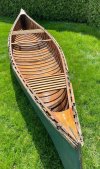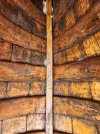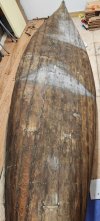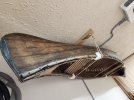Good afternoon.
I just acquire a cedar canoe that I plan to restore this upcoming winter, and I would have some questions.
I want to apologize first for my English, this is not my first language.
It begins when I was looking for a 16-foot chestnut prospector for a long time, and leaving in Montreal area it was quite difficult to found one, or it was around 400-500 kilometre away.
However, one day I end up finding one at 20 min away from where I live at a good price (180 CADollars) only downside it was a 14-foot-long, but I realized with time than when it comes to old cedar canoe you have to compromise or be really, really patient (or lucky).
On the announcement it was marked as a 14-foot-long chestnut prospector, and on the picture (in attachement) of the announcement I could see the slate seat and no quill which for me is a sign of prospectors canoe.
When I met the owner, we start talking, and I ask him If he knows the story of the canoe (I like when object come with history, it makes them more interesting),
He told me his parents bought it as a wedding gift in 1950 and the canoe came from the chestnut factory in Fredericton, but he didn’t recall if it was bought over there or if it came from there, the owner knew a bit about cedar canoe.
About the canoe itself it was left outside a few years because the owner didn’t have the space anymore to keep it inside, both canoe ends rot lightly plus some of the outside gunwales and some planking ,so far I found one broken ribs, not bad for my point of views for a first restoration.
After bringing back the canoe home I remove the canvas who was already half gone and start to take a look at his condition, It’s at this time that I notice two four-digit number on the stem : 1447 5600.
I was a bit of surprise knowing the 4-digit number specially beginning 14 was usually use on Peterborough canoe and after looking 1447 correspond to the muskrat Peterborough which is a 14 foots long trapper canoe. After checking dimension it looks like it could be a muskrat Peterborough.
Sorry about the long introduction, but here are my questions :
-It is possible that this canoe is a Peterborough muskrat from 1950 made in chestnut factory in Fredericton ?
-I know 14 foot canoe is not the best size for two or more people. I know this canoe might be not suitable for 4 (two adult and 2 kids under 10) but could it be a good canoe for example two people going fishing or even cruising on lake in family, or this is too optimist to ask for a 14 foot ?
We already have a 16-foot canoe in fibreglass for week end trip with load. The original plan was to restore a 16-foot canvas canoe prospector to replace the fibreglass canoe with. I imagine this will not feasible with this 14-foot canoe.
Thank you very much.
I just acquire a cedar canoe that I plan to restore this upcoming winter, and I would have some questions.
I want to apologize first for my English, this is not my first language.
It begins when I was looking for a 16-foot chestnut prospector for a long time, and leaving in Montreal area it was quite difficult to found one, or it was around 400-500 kilometre away.
However, one day I end up finding one at 20 min away from where I live at a good price (180 CADollars) only downside it was a 14-foot-long, but I realized with time than when it comes to old cedar canoe you have to compromise or be really, really patient (or lucky).
On the announcement it was marked as a 14-foot-long chestnut prospector, and on the picture (in attachement) of the announcement I could see the slate seat and no quill which for me is a sign of prospectors canoe.
When I met the owner, we start talking, and I ask him If he knows the story of the canoe (I like when object come with history, it makes them more interesting),
He told me his parents bought it as a wedding gift in 1950 and the canoe came from the chestnut factory in Fredericton, but he didn’t recall if it was bought over there or if it came from there, the owner knew a bit about cedar canoe.
About the canoe itself it was left outside a few years because the owner didn’t have the space anymore to keep it inside, both canoe ends rot lightly plus some of the outside gunwales and some planking ,so far I found one broken ribs, not bad for my point of views for a first restoration.
After bringing back the canoe home I remove the canvas who was already half gone and start to take a look at his condition, It’s at this time that I notice two four-digit number on the stem : 1447 5600.
I was a bit of surprise knowing the 4-digit number specially beginning 14 was usually use on Peterborough canoe and after looking 1447 correspond to the muskrat Peterborough which is a 14 foots long trapper canoe. After checking dimension it looks like it could be a muskrat Peterborough.
Sorry about the long introduction, but here are my questions :
-It is possible that this canoe is a Peterborough muskrat from 1950 made in chestnut factory in Fredericton ?
-I know 14 foot canoe is not the best size for two or more people. I know this canoe might be not suitable for 4 (two adult and 2 kids under 10) but could it be a good canoe for example two people going fishing or even cruising on lake in family, or this is too optimist to ask for a 14 foot ?
We already have a 16-foot canoe in fibreglass for week end trip with load. The original plan was to restore a 16-foot canvas canoe prospector to replace the fibreglass canoe with. I imagine this will not feasible with this 14-foot canoe.
Thank you very much.
Attachments
Last edited:




